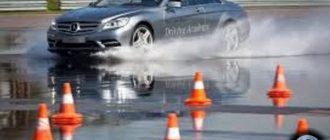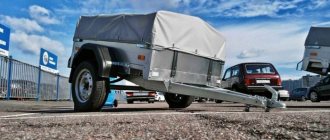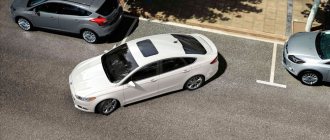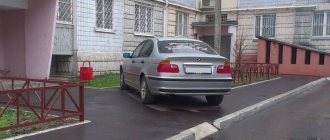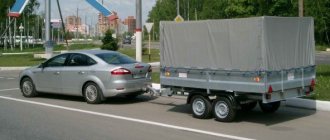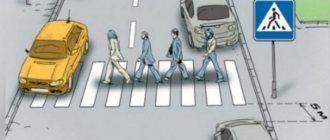Training in driving schools is now streamlined, and in a short period of time it is very difficult to master all the subtleties of driving, including learning how to properly reverse park between cars.
Beginners often lack parking skills. Without it, it will be very difficult in the city. In any city there is often a shortage of parking spaces and space is limited. Novice drivers may even experience fear. Incorrect actions can lead to accidents. And even if a car enthusiast knows how to park in front, parking in reverse can be a big problem for most. Let's look at the basic schemes, rules, and nuances of this process.
These tips will be very useful for those who have recently gotten behind the wheel of their own car.
[su_divider top=»no» style=»double» divider_color=»#238516" size=»6" margin=»5"]
Current Auto News
[su_cu[su_custom_gallery source=»posts: recent» limit=»3" link=»post» target=»blank» width=»190" height=»190" title=»always»]p>[su_divider [su_divider top= "no" style="double" divider_color="#238516" size="6" margin="5"]how to master reversing?
Maneuvering in reverse in the city is quite dangerous. Often the danger is that the driver does not receive enough information about people on the road or other objects that are behind the car. That is why, to confidently move backwards, you need to adjust the side mirrors. Experienced car enthusiasts recommend adjusting the mirrors so that 15% of the rear fenders can be seen, and the rest is an overview of the situation.
You need to make sure that the mirrors are not skewed either up or down. But you still have to tilt the side mirrors down. Reversing parking next to a curb is impossible without tilting the mirror correctly. Don't trust the mirror Experienced drivers confidently say that you shouldn't rely too much on the mirror. Especially you should not trust the salon curved one.
They distort too much the real distances to objects or obstacles. Naturally, this fact prevents a beginner from parking correctly. To fully control the movement and situation behind your car, it is better to turn around and watch through the rear window. This way you can get a much larger amount of information.
In theory, driving backwards is very easy. If you turn the steering wheel to the right, the car will turn to the right, and vice versa. When a novice car enthusiast leaves the walls of the racetrack, and there is no longer an experienced instructor nearby, this knowledge disappears somewhere. To prevent parking a car in reverse from leading to emergency situations, you need to master the skill of moving slowly in reverse. If this is not the case, then you do not need to fully release the clutch pedal. Here it is recommended to work more impulsively.
If you need to move, release the pedal; if you want to start rolling, press the clutch pedal to the floor. Don't put too much pressure on the gas. Some novice drivers, who receive important knowledge and driving lessons in various driving schools, learn to drive in reverse only using the clutch. No gas at all. It is not right.
In real conditions, situations are different. Regarding the steering, you can also note that for beginners it is better to use the rear window as a windshield. So, just turn the body back. Turning the steering wheel will turn the rear of the car to the right, and vice versa. It is important to understand that absolutely any car is more maneuverable when in reverse. There are sharper turning angles here. It is important not to lose the position of the steering wheel, in which the car drives straight. This knowledge and skills are very important.
Without them, you won't be able to park correctly. This can lead to ridiculous accidents, scratched foreign cars and various troubles. Reverse parking for beginners
If you want to improve your skills or learn how to park backwards from scratch, then you can’t do without training. A special platform is suitable for this. There may already be markings on it, but if not, then you can place pegs or stands on the site. They play the role of other machines. The distance between these “cars” should be twice the length of your car. Pegs are not only a great training method. It is also cost effective.
If your car collides with a pillar, it is much cheaper than colliding with an expensive foreign car.
Parallel Parking Basics
The most effective method of mastering the rules of how to park in reverse between cars is to practice driving in conditions that are as close to reality as possible. Having placed your car in line with another car, try, slowly reversing, to take the free space between the car behind and the vehicle in front. Effective training in parallel parking is only possible when the distance between cars does not exceed 50 cm.
The entire parallel parking procedure goes as follows:
- Slowly moving backwards, turn the steering wheel to the right until the extension of the left side of your car passes the point of the right front of the car behind.
- Turn the wheels in the opposite direction until they assume a straight position.
- Continuing to move slowly, move until the right side of your car passes the rear left corner of the car in front.
- Turn the steering wheel to the left (the front car is left behind).
- Slowly approach the vehicle behind you and stop.
- By leaving the wheels turned to the left, you will not have problems leaving the parking lot.
Video tutorials on proper parallel parking:
The main rule during the entire parking procedure is no rush. If you follow it, success is guaranteed.
Feel the dimensions when parking
Parking in reverse without being aware of your dimensions is almost impossible. It is developed with experience, and those drivers who perfectly understand the size of their car have worked on it for a couple of years. This cannot be taught, you just have to try. How to park correctly? When a motorist tries to park somewhere, it is necessary to ensure the correct division of attention.
When reversing, it is important not only to turn your head in all directions, but also to look in the mirrors. Just looking back is great, but everything that is below the level is hidden from view. Mirrors allow you to obtain more accurate information about the obstacle. This way you can control the situation in every sense, and the car will be more maneuverable. When reversing, let it be parking in reverse between two cars, you must take into account that those cars with rear-wheel drive have a minimum turning radius.
For all-wheel drive vehicles this figure is maximum. When planning to park, mentally draw a trajectory of movement, and then you will understand much faster how and what to do.
Reverse parking
Parallel parking in reverse is one of the typical ones. This scheme is really complicated. Here you need to take into account literally every little detail.
When preparing for a maneuver, you need to align yourself with the cars next to your place. The distance between your car and another should not be more than 1.5 m.
First of all, position your car parallel to the car that will be in front after the maneuver.
[su_divider top=»[su_divider top=»no» style=»double» divider_color=»#238516" size=»6" margin=»5"]line Autonews
[su_custom_gallery source[su_custom_gallery source=»taxonomy: post_tag/1100,1319,1524" limit="3" link="post" target="blank" width="190" height="190" title="always"]" no" style="d[su_divider top="no" style="double" divider_color="#238516" size="6" margin="5"] of your car should be as clearly as possible opposite the wheels of this car.
It is quite difficult to understand how to park in reverse. The diagram will help you navigate better.
Now turn the steering wheel all the way to the right and carefully start moving backwards. In this case, the situation needs to be controlled in the left mirror. Continue driving until you see the headlight of a car behind you. Then you can set the steering wheel straight and drive like this until you see the rear of the car in front of you.
Now you can turn the steering wheel to the left while continuing to move. The car will park parallel to the curb. When parallel parking in reverse, pay close attention to the front of your car. The important thing here is not to damage the object that is in front. Then all that remains is to level the car. This is to make it easier for you to leave your location.
It is quite possible to learn how to park using this scheme. The main thing is to understand the procedure and practice the theory in practice. If something doesn't work out for you, don't be upset. After all, parallel parking in reverse for beginners is not so easy.
A simple reverse parking scheme that will help beginners avoid a lot of problems
Any novice driver sooner or later faces the problem of proper parking. It is worth noting that when teaching in most driving schools, very little attention is paid to this important skill. But its testing is of enormous importance for the safety of the car owner and the integrity of his vehicle. Due to certain circumstances, driving schools provide a limited number of hours for practicing parking skills. As a result, new motorists are forced to gain experience parking right on the road, which can lead to serious consequences, at a minimum: a broken bumper (their own and someone else’s), and at maximum: a serious car accident.
This state of affairs leads to the fact that new drivers who have received a license to drive a vehicle do not have the necessary parking skills. Many people simply don’t know how to park. Of course, all the consequences of such careless training remain on the conscience of the instructors, who are not able to clearly tell and teach how to park correctly. Today we decided to talk about an elementary parking scheme that all beginners can use in everyday life.
Let's look at this scheme using one of the simplest examples. In front of us is a parking lot with only one space available. Everyone else is occupied by other machines.
The owner of car number one needs to park correctly between numbers two and three. In order to simplify your subsequent exit, you need to drive in reverse. At the same time, a distance of at least 1.5 meters must be maintained between vehicles. You should start your parking maneuver by determining the distance between vehicles. By maintaining a distance of 1.5 meters, the driver will not have any difficulty parking between two cars without damaging them.
Particular attention must be paid to the distance between the right side of the parking vehicle and other cars. Let's face it, the optimal distance of one and a half meters is very rare in modern megacities. Newbies often have to navigate current circumstances. Let's assume that the initial distance between cars is the notorious one and a half meters. In order to make a maneuver, you need to engage first gear and start moving, increasing the distance between the right side of the vehicle performing the maneuver and other cars.
After the parking car reaches number 3, you need to open the rear right window. By looking through it, you can easily monitor the narrowing distance between vehicles. Particular attention should be paid to the right headlight of car number 3. Next, you need to slowly move between the cars until the right headlight of the neighboring car disappears from view.
Of course, the correctness of actions directly depends on the distance between vehicles. If one and a half meters are observed, you can safely drive in until the headlight disappears in the right rear window. However, if the distance between the vehicles is about a meter, you need to drive in smoothly until the car is in the center of the right rear window. If the distance is less than a meter, you must continue driving until the headlight appears in the right rear window. After the conditions in all three schemes are met, press the brake.
After performing the maneuver, you must make sure that none of the neighboring vehicles are damaged. In addition, you need to check whether parking has caused anyone any additional problems or inconveniences. After this, we engage the right turn and reverse gear. Turn the steering wheel to the right and start moving smoothly. At this moment, do not forget about the distance with vehicle number 3. This can only be done through the rear view glass.
After making sure that the distance is maintained, it is necessary to continue the race, maintaining the extreme right position of the steering wheel. Until the moment when the rear of the car does not move into the space allotted to it by at least a third. Don't forget to keep your distance from nearby cars using the outside rear-view mirrors. In addition, it is important to periodically look in the rearview mirror to ensure that there are no obstacles behind the car. After the car has driven into the parking lot about a third of the way and is parallel to the sides of the adjacent cars, you need to stop and twist the steering wheel until the wheels are parallel to the body. After this, you can continue entering the parking lot. When the vehicle reaches its neighbors, you must stop, making sure that the boundaries of the intersection of the parking space have not been violated.
This is what reverse parking looks like at a 90 degree angle. This skill will be especially useful for residents of large cities, where there is always a shortage of parking spaces on the sites of shopping centers, in the courtyards of housing complexes, and near public places.
What reverse parking lifehacks can you share? Write comments, like, and subscribe to our channel.
About rear perpendicular parking
This scheme is a method in which the car is installed parallel to other cars that are next to you, but also perpendicular to the curb. For those who do not find this method difficult, it will make it very easy to park and enter garages.
If you want perfect perpendicular parking in reverse, it's worth practicing again. You don’t have to look for a suitable site for this. Your garage is suitable as such. Try to drive carefully into and out of the garage. You should strive to perform all actions almost automatically. Many novice drivers prefer to use a pre-drawn diagram for this.
Parking training exercises
To improve your parking skills, you can go to a race track and do a number of exercises:
- parallel parking: the driver must stand as close as possible to the edge of the area or to the cones without hitting the equipment with the right wheel;
- Reverse parking: the driver needs to drive the right side of the car as close as possible to the installed cone.
- leaving a parking space: the driver needs to leave the space without hitting the training markings;
- driving into the garage is one of the students’ least favorite exercises, but it is one of the most effective. After training, the driver will not only be able to drive into narrow spaces, but will also have a good feel for the dimensions of the car.
For training, you need a flat, paved area and equipment (you can use traffic cones and old tires as guides).
Parking algorithm
Choose a suitable place where you will park your car, drive up to it. Your task is to park in reverse.
The scheme involves stopping about a meter from other parked cars. Next, draw a mental line.
It will start at the center of the rear wheel and end at the level of the seat.
When you connect it to another vertical line, you get a point. It should be somewhere around the rear wheel arch.
Mentally find the point on the marking where you will turn. Turn right and reverse gear.
When the line connects with the parking spot, turn the steering wheel one and a half turns. Move as slowly as possible.
It is important to feel the dimensions of your car. Head straight to the center of the parking lot. When you stand parallel to others, align the wheels.
Then move back further until you stand next to others.
Always look back and to the sides.
Also pay attention to mirrors.
Reverse parking between two cars or any other method requires concentration and attention, especially for beginners.
Also keep in mind that you will need to get out somehow.
Therefore, estimate the distance that is enough to open the doors.
Master this algorithm until everything comes out automatically. If you are not sure yet, buy parking sensors. This way you will protect yourself and other cars.
Such a scheme and skills will be very useful to you on the road. This is nothing more than parking in reverse between cars.
It's just that instead of other cars you have a garage. But the algorithm of actions is the same.
[su_divider top=»no» style=»double[su_divider top=»no» style=»double» divider_color=»#238516" size=»6" margin=»5"]news
[su_custom_gallery source=»taxonomy: post_t[su_custom_gallery source=»taxonomy: post_tag/996,1187,1067" limit=»3" link=»post» target=»blank» width=»190" height=»190" title= "always"]e" divider_colo[su_divider top="no" style="double" divider_color="#238516" size="6" margin="5"]I'm parking on the right
Step 1: Select a parking space. In the parking lot, follow the same rules as on the road, keeping to the right side of the lane between rows of parked cars.
Once you've chosen a parking spot to the right of your car, turn on your right turn signal to let other drivers know you plan to park there.
Drive slowly past an available parking space, making sure there is enough space for your vehicle. Check the parking lot for any obstructions and make sure the cars on both sides are actually parked.
When you drive by, reduce your speed to a minimum. Stay about 1 meter away from parked cars.
When your rear bumper is level with the left side of the car parked to the right of your chosen spot (the brown car in the picture), come to a complete stop.
Step 2: Prepare to move. Engage reverse gear. Make sure the turn signal is on during the maneuver.
Look in your mirrors to make sure there are no other vehicles behind or near you.
Keep an eye on the right side of your vehicle using the right mirror. Keep the corner of the rear bumper in sight and maintain a distance between it and the parked vehicle.
Step 3: Start parking in reverse. Turn the steering wheel as far as possible to the right, then turn it half a turn to the left.
Advice. When reversing, place your right hand on the back of the front passenger seat and look over your right shoulder. The steering wheel can only be rotated with the left hand.
Drive slowly in reverse gear. You will find yourself in a parking area. Check your left mirror periodically to avoid colliding with a car to your left.
Step 4: Make adjustments if necessary. Make small adjustments using the steering wheel to center the vehicle in the parking space.
Advice. It is important to understand the overall dimensions of your vehicle. It is difficult to determine the length of a car from the driver's seat. If necessary, when parking, get out of the car and check its position to ensure that you will not hit other vehicles.
If you get too close to a car on the other side of your car, stop. Shift into first gear and lean forward slightly, correcting the position of the car in the parking space.
Step 5: Reverse all the way. Continue driving until the distance between the rear bumper and the edge of the parking space is 15-30 cm. Be aware of vehicles and obstacles such as curbs, lamp posts and supermarket carts. Leave 15-30 cm between the bumper and various obstacles.
Step 6: Set the parking brake. Estimate the distance between your car and other vehicles. Make sure to leave enough space for the doors to open.
If there is not enough room to get out of your car or cars nearby, engage first gear and slowly move forward, correcting the position of your car. Try to center your car and drive back.
Learning direct parking
This is a very simple and necessary method in the city. Here the car is parked along something in a straight line. If you decide to park this way, you don't need to drive too close to the objects in front of you.
Also don't forget about the doors. Pay attention to obstacles near your doors. When parking straight ahead, approach the car in front of you as close as possible to 1.5 m. Then start moving towards the curb.
Before the front wheels reach the curb 0.5 m, turn the car to the left. Then level off. This requires precise control skills. Focus on the dimensions of the car in front of you.
Also consider safe departure.
